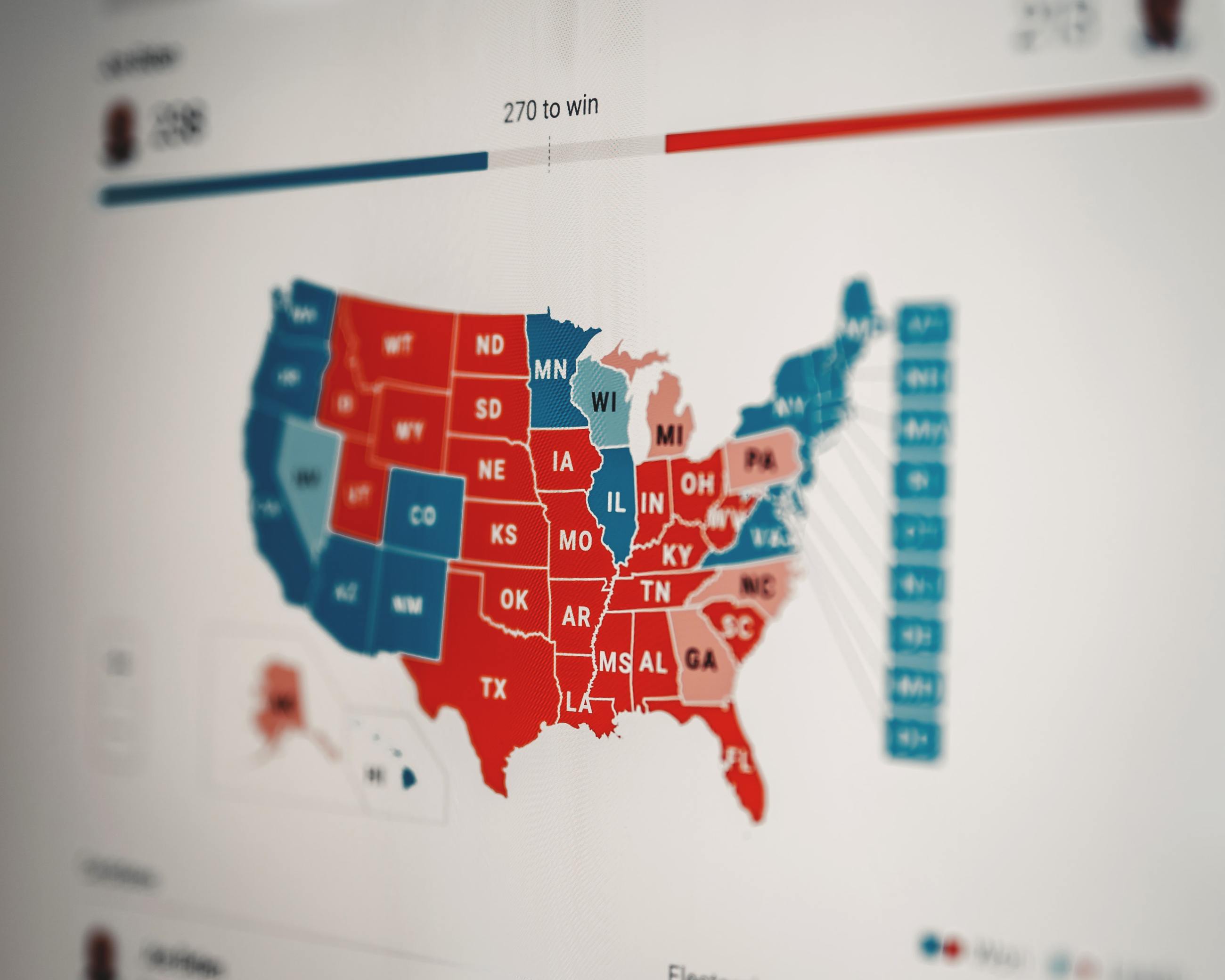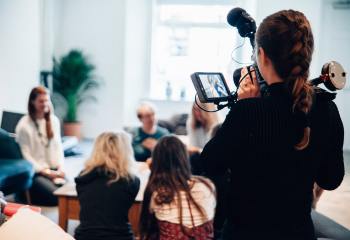
7 Innovative Projects That Supported Local Election Coverage Across the Country
Initiatives utilizing the Citizens Agenda, reporter training, fighting misinformation made a big difference in a challenging election year for local news
Imagine being a local reporter covering elections in 2020. Your news organization is probably struggling to cover the pandemic, racial justice protests, and every local election measure and candidate while also losing ad revenues. Even the work of being a reporter is challenging in these times of COVID-19, where you must be masked and socially distanced while covering events in person. And then there’s the added burden of debunking the plethora of rumors and misinformation on popular social media platforms.
Fortunately, 2020 is also a banner year for projects that support local news outlets by providing new ways of engaging with the public, giving timely training to reporters who have to cover a chaotic election and helping them sift through mushrooming misinformation. Many of these initiatives are collaborative so that reporters and editors can work as a team to take on difficult assignments. Even better: most of these projects are built to last beyond this election and into coverage of other topics.
Just how important and historic is the work being done? Melanie Plenda, director of the Granite State News Collaborative, says New Hampshire journalists at competing news outlets are working together in completely new ways.
“I know it sounds corny, but I’ve been in journalism for 22 years, and I’ve never seen a group of people come together like this for the purpose of providing the news that their communities needed,” Plenda told me. “It’s amazing.”
Here’s an overview of the most notable local news projects this election season.
Local News Initiatives for the Election
- The Citizens Agenda + Solutions Journalism
NYU professor Jay Rosen has long decried the “horse race” election coverage that obsesses over polling and who’s ahead in the race. In his 1992 book, What Are Journalists For? he called for a new “citizens agenda” of election coverage that put the community’s interests first. Decades later, his idea is finally blossoming with the help of collaborators such as Hearken, Trusting News and the Membership Puzzle Project (which Rosen co-founded).
How does it work? Rosen outlines the approach from a meeting he had with public radio station WBUR in Boston last year:
- Identify the people you are trying to inform
- Ask the people: “what do you want the candidates to be discussing as they compete for your votes?”
- Publish the “citizens agenda”
- Press candidates to address the agenda
- Build your voters guide around that.
Rosen told me that the simple voters guide is the “single most valuable thing that local newsrooms can produce.” And he connected this approach directly to improved revenues.
“If your citizens agenda approach is done well, and the priorities you get back from that question are what your readers want candidates to be talking about, then you have proven why you deserve a subscription,” he said. “That’s why it’s not going to go away.”
Meanwhile, Linda Shaw of Solutions Journalism Network has been supporting newsrooms in a “Citizens Solutions” project since early this year, combining the citizens agenda approach with solutions journalism.
“They reached out to their audiences to ask what issues they most want the candidates to be talking about,” Shaw told me. “Once they compiled and published their priorities, they then used them to question candidates and to write solutions-focused stories on some of those issues.”
Participants: The Citizens Solutions group includes Santa Cruz Local, Rockford Register Star (in partnership with Illinois Public Media), San Luis Obispo Tribune, Milwaukee Journal Sentinel, Cap Times in Madison, Wisc., Dallas Morning News, KALW, Daily Yonder.
Impact: “We’re hopeful participating newsrooms will not just keep this approach going for every subsequent election cycle, but also apply it to their political reporting and beyond,” said Jennifer Brandel, co-founder of Hearken, who also helped run the Election SOS training program with some of the same partners. After a Santa Cruz Local podcast mentioned the success of an Oregon policing program called CAHOOTS that dispatches mental health professionals instead of police in certain circumstances, the local candidates said they had meetings with law enforcement to discuss implementing it locally.
Stories of Note:
Help Set the Cap Times’ People’s Agenda (Cap Times)
How two communities on Milwaukee’s North Shore achieved sky-high levels of absentee voting despite coronavirus (Milwaukee Journal-Sentinel)
U.S. Senate Debate Reaction (New Mexico in Focus + New Mexico Black Voters Collaborative)
Bilingual videos, infographics, animated videos and virtual town halls (Enlace Latino NC)
A Twitter thread posted by Chalkbeat co-founder and CEO Elizabeth Green in early September laid out the idea for Votebeat: a pop-up newsroom that would place reporters into publications based in key states to cover election integrity. Within a month, the newsroom sprang to life with reporters hired to cover eight states: California, Georgia, Michigan, New Jersey, North Carolina, Pennsylvania, Texas and Wisconsin. Created by Chalkbeat, Votebeat raised nearly $1 million from major donors, individual donors and local foundations to hire the reporters, according to Chalkbeat chief strategy officer Alison Go in a piece for Nieman Reports.
Go told me that they were able to get the newsroom up and running so quickly because they talked to a dozen key people who made them even more excited about the project. And they raised money through direct asks, Twitter and Instagram campaigns, a Zoom funder call and more.
“In some ways, the easiest step was building the newsroom,” Go said. “Part of our budget included paying for a centralized team to get this whole thing up and running. We had a potential project director already briefed on Votebeat before we finished fundraising, and when the last dollar came in, we onboarded him just hours later. Our partner newsrooms already had story ideas in the queue and local reporters waiting in the wings. The funding enabled those plans to come to life.”
Participants: CalMatters, WABE, Bridget Detroit, Bridge Michigan, NJ Spotlight, WFAE, Spotlight PA, Texas Tribune, WURD, and Wisconsin Watch.
Impact: “For the local news industry, we believe that Votebeat reinforces the idea that the single-subject model for local news is incredibly powerful,” Go said. “It produces deep and broad impact, and brings new dollars into the ecosystem. We hope to see more newsrooms copy this nonprofit model beyond [covering] education and election integrity.”
Stories of Note:
Texas’ ability to run accessible, efficient elections is being tested this year. Will Bexar County flunk? (Texas Tribune)
Will Pa. be at the center of another Bush v. Gore? These 8 lawyers and scholars weigh in. (Spotlight PA)
Speaking of election integrity, ProPublica’s collaborative project, Electionland, started in 2016 as a hub for newsrooms across the country to report irregularities and problems for voters. There are many moving parts for this collaboration of local and national newsrooms (who can join for free), with partners such as First Draft and The Guardian, and funding from the Craig Newmark Philanthropies.
The collaboration offers newsrooms an incredible array of support, including real-time alerts about problems at polling locations, training, a private Slack group and promotion of stories. There’s even a map with Google Trends on places people are searching for “Did my vote count?” and “election results” (see above).
This year the project really took a leap forward, launching way back in January, covering the massive jump in mail-in voting and even giving out grants to four local newsrooms to partner on investigative stories, according to Rachel Glickhouse, partner manager for Electionland. They also translated stories into Spanish.
“We hired a temporary team of more than a dozen people working in shifts 6 days a week to cover early voting in real time for the entire month of October and through Election Day,” Glickhouse told me. “It was extraordinarily busy given the historic levels of early voting this year. We also worked with a class of graduate students from the Newmark Graduate of School of Journalism, since this year they had a dedicated ‘Electionland’ class.”
Participants: 160+ newsrooms.
Impact: “I hope we were able to provide useful information to the public about how to vote during a pandemic, and to pinpoint the problems that voters faced this year,” Glickhouse said. “I also think we continue to show that large-scale collaborative journalism is possible and can be successful, even under challenging conditions like a pandemic and economic crisis.”
Stories of Note:
In Florida, the Gutting of a Landmark Law Leaves Few Felons Likely to Vote (Miami Herald & Tampa Bay Times)
Why Do Nonwhite Georgia Voters Have to Wait in Line for Hours? (Georgia Public Broadcasting)
Pennsylvania’s New Vote-by-Mail Law Expands Access for Everyone Except the Poor (Philadelphia Inquirer)
Roundup of Election Day Coverage (ProPublica)
After what happened in 2016 with social media campaigns from Russia and others, it was a given that the 2020 elections would be flooded with misinformation and other threats to election integrity. So how can local news outlets cope with that flood? One interesting project is the Trusted Elections Network at the American Press Institute, bringing together a mix of local news outlets with civic organizations, academics and experts.
“We launched the Trusted Elections Network in March to connect newsroom leaders, voting and civic organizations, academic institutions and elections, legal and media experts to consider the best ways to address misinformation and other threats to secure, trusted elections in service of helping voters navigate an unusual year to vote,” said Andrew Rockway, senior community manager, elections for the API.
They provided grant money for more than 100 participating newsrooms, including nonprofits, metro dailies, public media and more. And the community managers at API have also written a series of great guides for reporters covering election integrity. This story on scenario planning for the election is a great example – and very relevant to how events unfolded.
The Network was so successful that it secured another round of funding to add an additional five newsrooms in October. Rockway believes that the Network will live on in some form after the election, focused on themes of information needs and engagement, solutions to important issues, and addressing issues of trust and polarization.
Participants: 109 newsrooms across the country, with 36 newsrooms receiving grants.
Impact: “This year has highlighted the importance of election administration – the process of casting, canvassing, and certifying votes – and the value of explanatory and service reporting to illuminate these systems and help people navigate the process of voting,” Rockway said. “As Jonathan Lai of the Philadelphia Inquirer says about covering the basics, ‘If I can convince people to be interested in our elections, they also then need information on candidates and campaigns in order to exercise that right.’ This spirit of explanatory reporting should inform coverage of future elections, and indeed, of other civic and government processes.”
Stories/Projects of Note:
How to Vote 2020 (translated in 5 languages) (Philadelphia Inquirer)
Mississippi Trusted Elections Guide (Mississippi Free Press)
An Election Kit from Newspack (a WordPress product for newsrooms) helped more than a dozen newsrooms customize sample ballot lookups. Examples from Carolina Public Press and Scalawag.
First Draft has been a godsend for journalists during this age of misinformation and disinformation. It’s a global partnership and has focused on journalist trainings and how to spot and track misinformation on social platforms. This year during the U.S. elections, First Draft started a new Local News Fellowship program, placing Fellows in newsrooms in Colorado, Florida, Michigan, Ohio and Wisconsin. Rather than being on-the-ground reporters as in the Votebeat project, the Fellows helped train newsrooms and communities to better understand election misinformation.
Project manager Nancy Watzman told me that the Fellows “concentrated not so much on stories as much as providing training, background research and engagement opportunities for local journalists.” Because one of the program’s goals was to nurture talent at the local level for tracking and countering misinformation, some Fellows did end up with additional funding to produce stories and other interesting projects.
“[Fellow] Shana Black also brought her teacher mojo to events such as a ‘game night,’ Jeopardy-style training about misinformation in collaboration with the local solutions journalism collaboration in Northeast Ohio,” Watzman told me.
Participants: Sandra Fish at Colorado Media Project; Damon Scott at WRLN in Miami; Serena Maria Daniels at Bridge Magazine in Detroit; Shana Black at Eye on Ohio; and Howard Hardee at Wisconsin Watch.
Impact: “Our local fellows will take the training they have had from First Draft with them to have continued careers in journalism and make a difference where they live,” Watzman said.
Stories/Projects of Note:
Falsehoods about Wisconsin’s vote count are flying. Here’s the truth. (Wisconsin Watch)
Imagínese si no pudiera leer esto (Imagine if you couldn’t read this) (Detroit Free Press)
Cleveland Votes (Black Girl in the CLE podcast)
News Consumers’ Toolkit: covering misinformation and disinformation (Election Integrity Project)
After the 2016 election, many newsrooms had to do some soul-searching about their disconnect from communities, especially from people who supported Donald Trump for president. That disconnect is probably most pronounced for public media. This was the impetus for a $1.9 million grant from the Corporation for Public Broadcasting to create the America Amplified engagement project in the 2020 election cycle. The goal was to get more voices into reporting for the election, but put the focus squarely on voters and not candidates.
“We’ve listened for connections between Americans’ concerns/hopes (including COVID-19) and civic action/inaction – whether it be around voting, advocacy or purely emotions,” said Donna Vestal, managing director of the project. “We held more than a dozen national listening sessions around the themes that had emerged.”
That led to an amazing array of public media programming, including a reporter taking a bike tour of small-town America; a look at New England’s racist history; and audio diaries of people working during the pandemic (see the links below). And there’s a six-episode national talk show, “America Amplified: Election 2020” with topics like political division, the shifting American Dream and how the media misses the stories of rural and Native American communities.
Vestal told me it’s been a real challenge to change the mindset of public media general managers at radio stations.
“They need to embed engagement into the business plan – it’s a long game and you have to understand it’s not about meeting the deadline of a story, a news hole, what the editor decides the story is,” she said. “It’s much more rewarding to build connections with communities, create a better feedback loop, and bring in a better diversity of audience perspectives. If we don’t do this and hold ourselves accountable to get community perspectives rather than expert perspectives, we will be extinct, and the community will do their own work.”
Participants: 50+ public radio stations, through eight public media collaborative networks (see the list of networks here).
Impact: “We’re in the middle of unpacking this, but my hope is that we are making such a strong case for community engagement journalism that newsrooms will build it into their ‘business plan,’” Vestal said. “We are revising our playbook and website to offer practical guidance based on roles: GM/leadership; news or content director; reporter/producer; talk show staff. No one should be doing this work on an island.”
Stories/Projects of Note:
Across The Great Divide: A Reporter, A Bicycle & 900 Miles Listening To Small Town America (Boise State Public Radio)
NENC/America Amplified Special: New England’s Abolitionist History at Odds With Racist Realities (New England News Collaborative)
This will go down as the U.S. election with the most cooperation ever among local news outlets. All the projects mentioned above are testament to that. But what really stands out is how competing news organizations were able to come together to cover the election in the state of New Hampshire. The Granite State News Collaborative – with newspapers, public media, magazines, community partners and more – was already covering COVID-19 together, so it had the infrastructure in place.
Melanie Plenda, project manager for the Collaborative, noted that they had started as a project-based initiative of Solutions Journalism Network, but were now becoming a stand-alone organization. For the election, Plenda told me it was a truly historic collaboration of competing news outlets across the state. What made it work? The Collaborative had a team of 15+ freelance reporters stationed around the state, ready for action depending on the stories that popped up.
“The tips came to me, and then I reached out to appropriate outlets,” Plenda said. “If they needed a freelancer, I could assign them. It really helped because smaller news outlets could redeploy resources to cover local races while using other people’s coverage of the U.S. Senate and presidential races.”
Just the fact that not every news outlet in the state had to cover the same candidate campaign stops and press conferences and could focus on their communities was a real game-changer for the state’s news media.
“There was so much fear and anxiety and confusion around this election,” Plenda said. “People were looking to us to help them locally.”
Participants: The Collaborative includes 18 newsroom partners and 10 community engagement partners. You can see the list here.
Impact: “We have a big project coming up [about the lack of diversity in New Hampshire] that has garnered even more enthusiasm, and more participation, because [the collaboration partners] can see how this can work,” said Plenda. “I think they are good with sharing content, but now there’s a way we can co-report things in our region. That’s different too – there’s a structure and mechanism for how that would work.”
Stories of Note:
What You Need to Know Before Voting in Person (Spanish/English) (Granite State News Collaborative)
Election 2020: Voters Brace for Guns and Intimidation at the Polls (Granite State News Collaborative)
An Outlier of Asian Americans in the Election: Conservative Vietnamese Voters (Granite State News Collaborative)
All the Collaborative’s Election 2020 stories are here.
*****
Interested in supporting the election work of local nonprofit newsrooms? Find out how your donations can be doubled or tripled at the NewsMatch website, and keep an eye out for your local nonprofit newsroom’s fundraising campaign, running through the end of the year.
Mark Glaser is a consultant and advisor with a focus on supporting local and independent news in America. He was the founder and executive director of MediaShift.org, and is an associate at Dot Connector Studio, and innovation consultant at the New Mexico Local News Fund.
Photo (top) by Clay Banks on Unsplash
Recent Content
-
Journalismarticle ·
-
Journalismarticle ·
-
Journalismarticle ·





